GEOP830 - Sustainable Urbanization: A Critical Reflection Essay
VerifiedAdded on 2023/04/25
|5
|1359
|500
Essay
AI Summary
This essay critically reflects on urbanization, viewing it as a transformation from rural to urban settings, driven by opportunities and investments, while acknowledging the challenge of sustainability. It emphasizes the need for sustainable urbanization, focusing on housing that is decent, affordable, and environmentally friendly, alongside prioritizing sustainable social amenities like education, healthcare, and recreational facilities. The reflection further addresses the importance of sustainable transportation solutions, such as renewable energy and public transport, and the necessity of adaptive urban management models that balance service delivery with resource utilization. The essay concludes by advocating for the integration of sustainability into urbanization to ensure a future where urban living does not overexploit natural resources or harm the environment. Desklib provides access to similar essays and study resources for students.
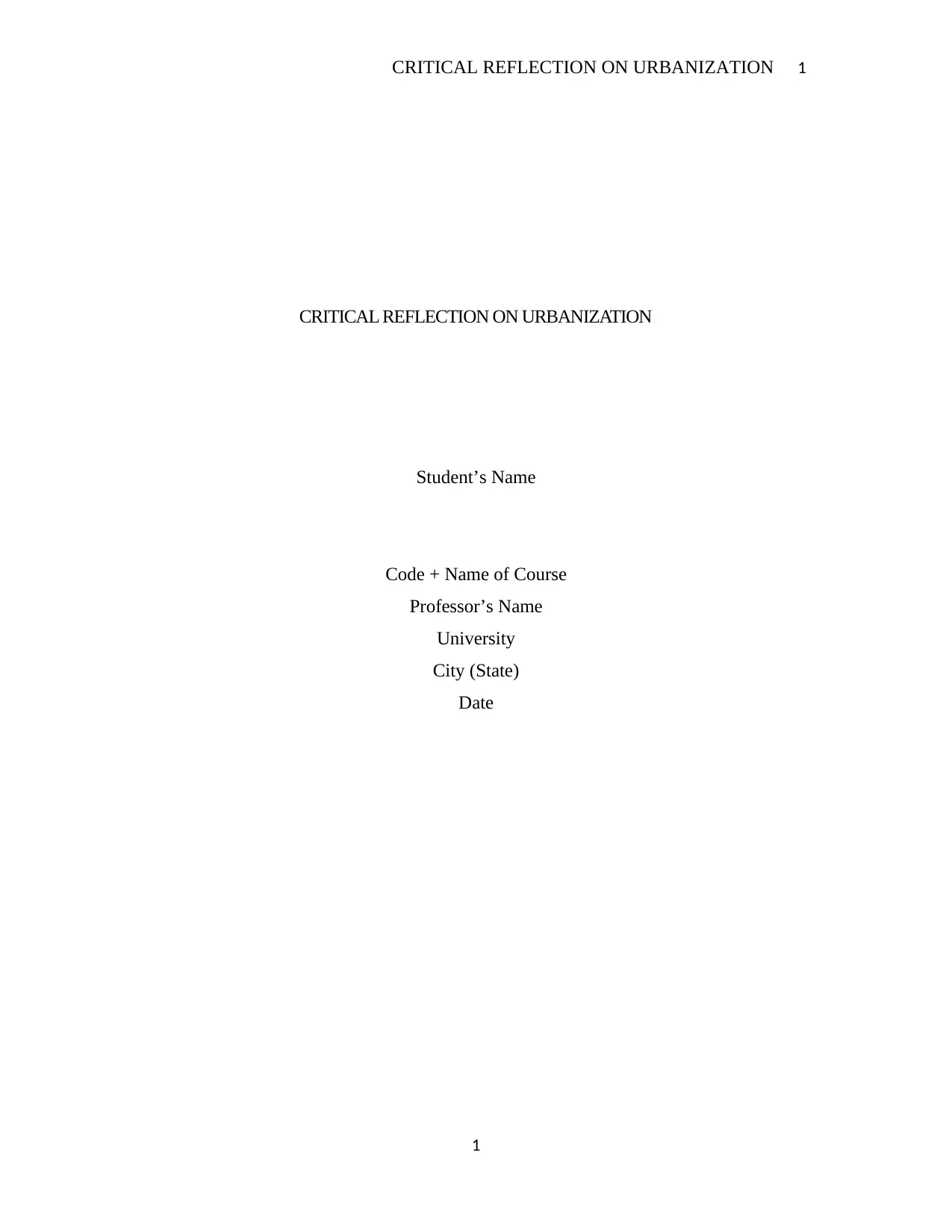
CRITICAL REFLECTION ON URBANIZATION 1
CRITICAL REFLECTION ON URBANIZATION
Student’s Name
Code + Name of Course
Professor’s Name
University
City (State)
Date
1
CRITICAL REFLECTION ON URBANIZATION
Student’s Name
Code + Name of Course
Professor’s Name
University
City (State)
Date
1
Paraphrase This Document
Need a fresh take? Get an instant paraphrase of this document with our AI Paraphraser
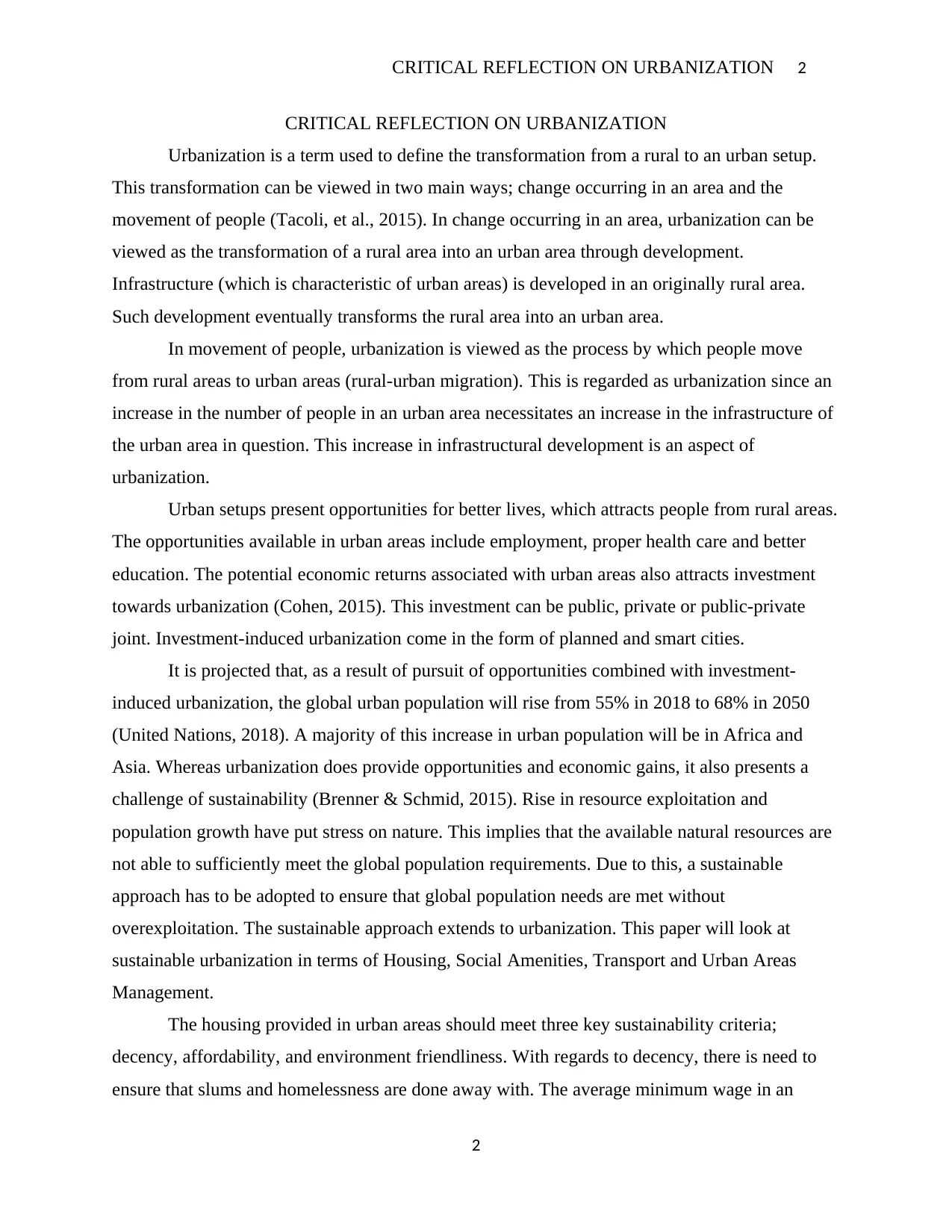
CRITICAL REFLECTION ON URBANIZATION 2
CRITICAL REFLECTION ON URBANIZATION
Urbanization is a term used to define the transformation from a rural to an urban setup.
This transformation can be viewed in two main ways; change occurring in an area and the
movement of people (Tacoli, et al., 2015). In change occurring in an area, urbanization can be
viewed as the transformation of a rural area into an urban area through development.
Infrastructure (which is characteristic of urban areas) is developed in an originally rural area.
Such development eventually transforms the rural area into an urban area.
In movement of people, urbanization is viewed as the process by which people move
from rural areas to urban areas (rural-urban migration). This is regarded as urbanization since an
increase in the number of people in an urban area necessitates an increase in the infrastructure of
the urban area in question. This increase in infrastructural development is an aspect of
urbanization.
Urban setups present opportunities for better lives, which attracts people from rural areas.
The opportunities available in urban areas include employment, proper health care and better
education. The potential economic returns associated with urban areas also attracts investment
towards urbanization (Cohen, 2015). This investment can be public, private or public-private
joint. Investment-induced urbanization come in the form of planned and smart cities.
It is projected that, as a result of pursuit of opportunities combined with investment-
induced urbanization, the global urban population will rise from 55% in 2018 to 68% in 2050
(United Nations, 2018). A majority of this increase in urban population will be in Africa and
Asia. Whereas urbanization does provide opportunities and economic gains, it also presents a
challenge of sustainability (Brenner & Schmid, 2015). Rise in resource exploitation and
population growth have put stress on nature. This implies that the available natural resources are
not able to sufficiently meet the global population requirements. Due to this, a sustainable
approach has to be adopted to ensure that global population needs are met without
overexploitation. The sustainable approach extends to urbanization. This paper will look at
sustainable urbanization in terms of Housing, Social Amenities, Transport and Urban Areas
Management.
The housing provided in urban areas should meet three key sustainability criteria;
decency, affordability, and environment friendliness. With regards to decency, there is need to
ensure that slums and homelessness are done away with. The average minimum wage in an
2
CRITICAL REFLECTION ON URBANIZATION
Urbanization is a term used to define the transformation from a rural to an urban setup.
This transformation can be viewed in two main ways; change occurring in an area and the
movement of people (Tacoli, et al., 2015). In change occurring in an area, urbanization can be
viewed as the transformation of a rural area into an urban area through development.
Infrastructure (which is characteristic of urban areas) is developed in an originally rural area.
Such development eventually transforms the rural area into an urban area.
In movement of people, urbanization is viewed as the process by which people move
from rural areas to urban areas (rural-urban migration). This is regarded as urbanization since an
increase in the number of people in an urban area necessitates an increase in the infrastructure of
the urban area in question. This increase in infrastructural development is an aspect of
urbanization.
Urban setups present opportunities for better lives, which attracts people from rural areas.
The opportunities available in urban areas include employment, proper health care and better
education. The potential economic returns associated with urban areas also attracts investment
towards urbanization (Cohen, 2015). This investment can be public, private or public-private
joint. Investment-induced urbanization come in the form of planned and smart cities.
It is projected that, as a result of pursuit of opportunities combined with investment-
induced urbanization, the global urban population will rise from 55% in 2018 to 68% in 2050
(United Nations, 2018). A majority of this increase in urban population will be in Africa and
Asia. Whereas urbanization does provide opportunities and economic gains, it also presents a
challenge of sustainability (Brenner & Schmid, 2015). Rise in resource exploitation and
population growth have put stress on nature. This implies that the available natural resources are
not able to sufficiently meet the global population requirements. Due to this, a sustainable
approach has to be adopted to ensure that global population needs are met without
overexploitation. The sustainable approach extends to urbanization. This paper will look at
sustainable urbanization in terms of Housing, Social Amenities, Transport and Urban Areas
Management.
The housing provided in urban areas should meet three key sustainability criteria;
decency, affordability, and environment friendliness. With regards to decency, there is need to
ensure that slums and homelessness are done away with. The average minimum wage in an
2
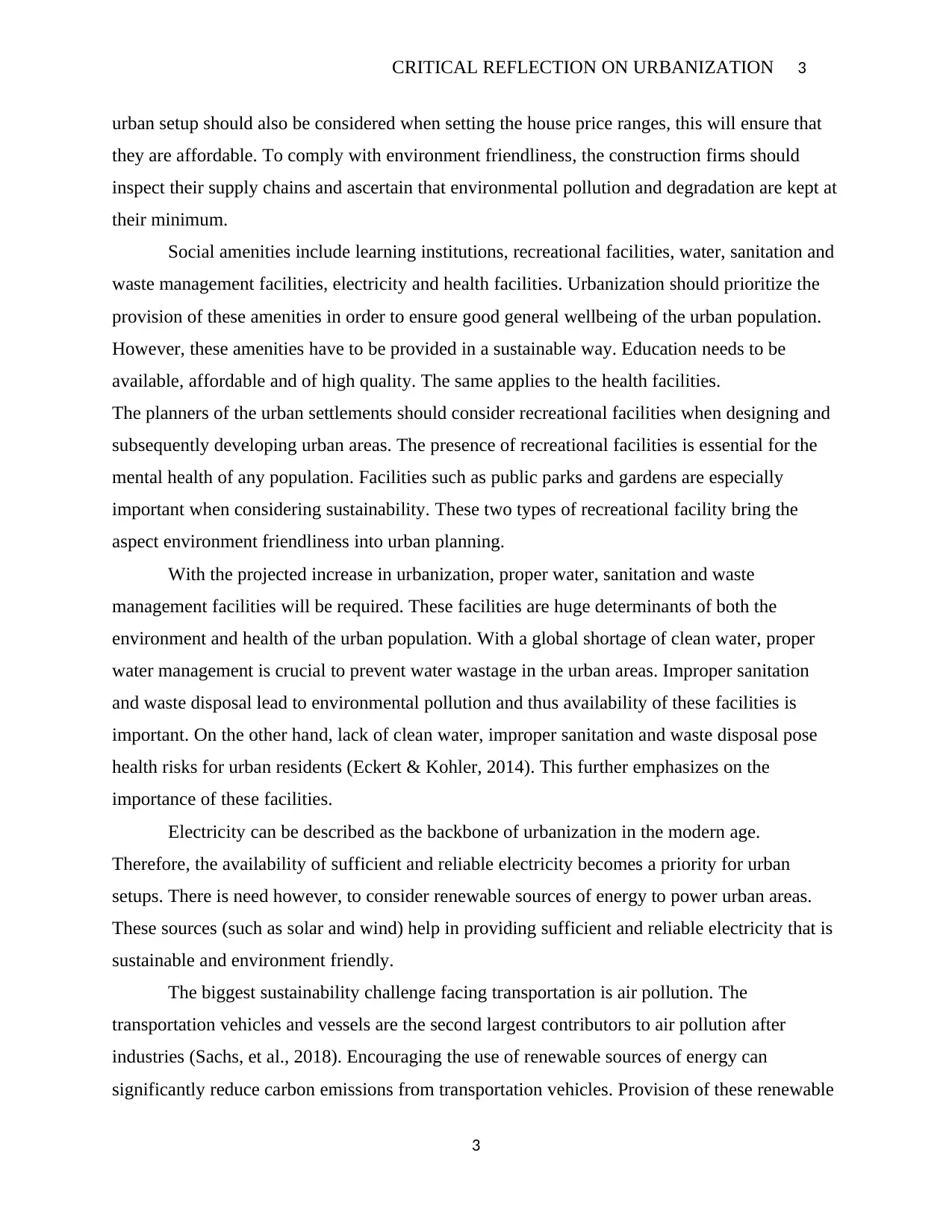
CRITICAL REFLECTION ON URBANIZATION 3
urban setup should also be considered when setting the house price ranges, this will ensure that
they are affordable. To comply with environment friendliness, the construction firms should
inspect their supply chains and ascertain that environmental pollution and degradation are kept at
their minimum.
Social amenities include learning institutions, recreational facilities, water, sanitation and
waste management facilities, electricity and health facilities. Urbanization should prioritize the
provision of these amenities in order to ensure good general wellbeing of the urban population.
However, these amenities have to be provided in a sustainable way. Education needs to be
available, affordable and of high quality. The same applies to the health facilities.
The planners of the urban settlements should consider recreational facilities when designing and
subsequently developing urban areas. The presence of recreational facilities is essential for the
mental health of any population. Facilities such as public parks and gardens are especially
important when considering sustainability. These two types of recreational facility bring the
aspect environment friendliness into urban planning.
With the projected increase in urbanization, proper water, sanitation and waste
management facilities will be required. These facilities are huge determinants of both the
environment and health of the urban population. With a global shortage of clean water, proper
water management is crucial to prevent water wastage in the urban areas. Improper sanitation
and waste disposal lead to environmental pollution and thus availability of these facilities is
important. On the other hand, lack of clean water, improper sanitation and waste disposal pose
health risks for urban residents (Eckert & Kohler, 2014). This further emphasizes on the
importance of these facilities.
Electricity can be described as the backbone of urbanization in the modern age.
Therefore, the availability of sufficient and reliable electricity becomes a priority for urban
setups. There is need however, to consider renewable sources of energy to power urban areas.
These sources (such as solar and wind) help in providing sufficient and reliable electricity that is
sustainable and environment friendly.
The biggest sustainability challenge facing transportation is air pollution. The
transportation vehicles and vessels are the second largest contributors to air pollution after
industries (Sachs, et al., 2018). Encouraging the use of renewable sources of energy can
significantly reduce carbon emissions from transportation vehicles. Provision of these renewable
3
urban setup should also be considered when setting the house price ranges, this will ensure that
they are affordable. To comply with environment friendliness, the construction firms should
inspect their supply chains and ascertain that environmental pollution and degradation are kept at
their minimum.
Social amenities include learning institutions, recreational facilities, water, sanitation and
waste management facilities, electricity and health facilities. Urbanization should prioritize the
provision of these amenities in order to ensure good general wellbeing of the urban population.
However, these amenities have to be provided in a sustainable way. Education needs to be
available, affordable and of high quality. The same applies to the health facilities.
The planners of the urban settlements should consider recreational facilities when designing and
subsequently developing urban areas. The presence of recreational facilities is essential for the
mental health of any population. Facilities such as public parks and gardens are especially
important when considering sustainability. These two types of recreational facility bring the
aspect environment friendliness into urban planning.
With the projected increase in urbanization, proper water, sanitation and waste
management facilities will be required. These facilities are huge determinants of both the
environment and health of the urban population. With a global shortage of clean water, proper
water management is crucial to prevent water wastage in the urban areas. Improper sanitation
and waste disposal lead to environmental pollution and thus availability of these facilities is
important. On the other hand, lack of clean water, improper sanitation and waste disposal pose
health risks for urban residents (Eckert & Kohler, 2014). This further emphasizes on the
importance of these facilities.
Electricity can be described as the backbone of urbanization in the modern age.
Therefore, the availability of sufficient and reliable electricity becomes a priority for urban
setups. There is need however, to consider renewable sources of energy to power urban areas.
These sources (such as solar and wind) help in providing sufficient and reliable electricity that is
sustainable and environment friendly.
The biggest sustainability challenge facing transportation is air pollution. The
transportation vehicles and vessels are the second largest contributors to air pollution after
industries (Sachs, et al., 2018). Encouraging the use of renewable sources of energy can
significantly reduce carbon emissions from transportation vehicles. Provision of these renewable
3
⊘ This is a preview!⊘
Do you want full access?
Subscribe today to unlock all pages.

Trusted by 1+ million students worldwide
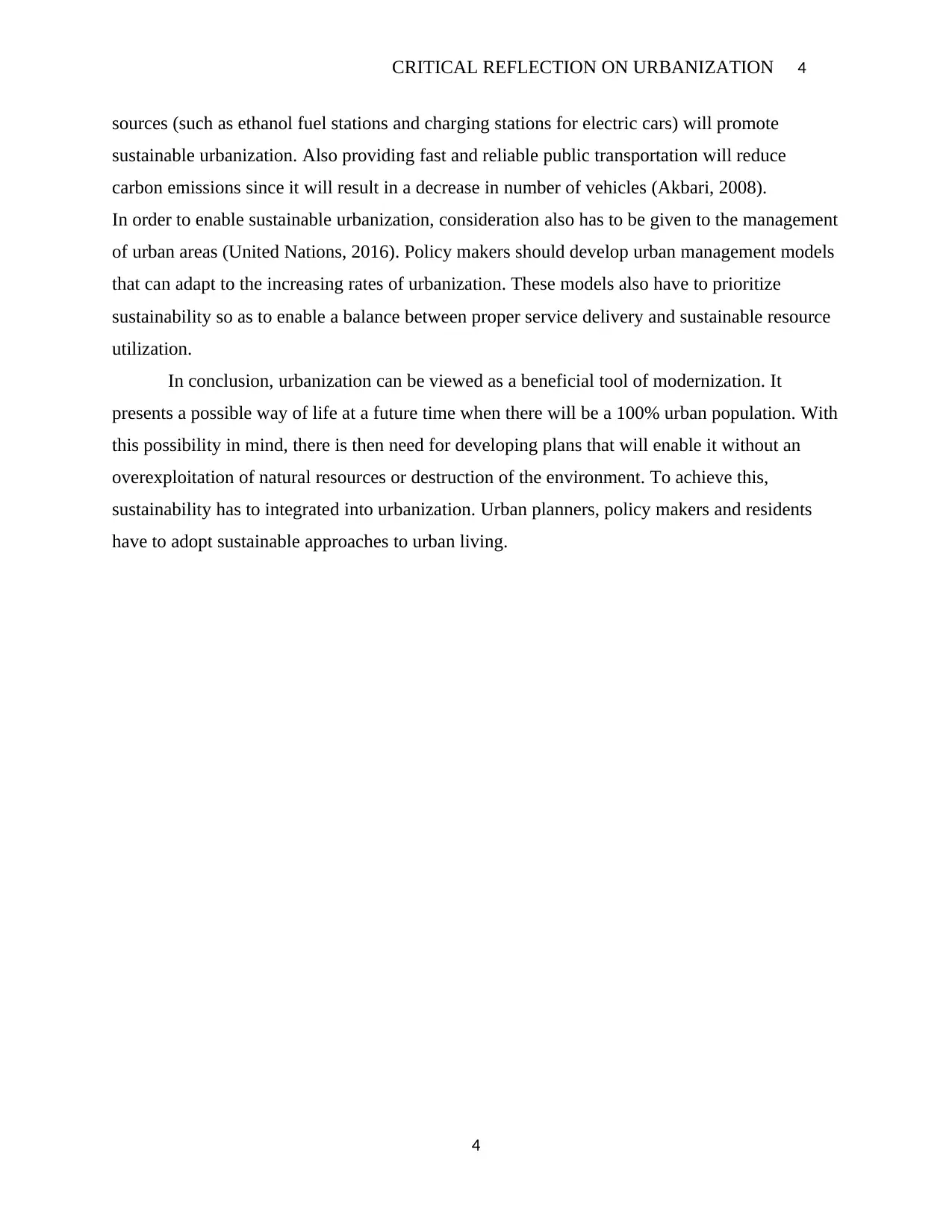
CRITICAL REFLECTION ON URBANIZATION 4
sources (such as ethanol fuel stations and charging stations for electric cars) will promote
sustainable urbanization. Also providing fast and reliable public transportation will reduce
carbon emissions since it will result in a decrease in number of vehicles (Akbari, 2008).
In order to enable sustainable urbanization, consideration also has to be given to the management
of urban areas (United Nations, 2016). Policy makers should develop urban management models
that can adapt to the increasing rates of urbanization. These models also have to prioritize
sustainability so as to enable a balance between proper service delivery and sustainable resource
utilization.
In conclusion, urbanization can be viewed as a beneficial tool of modernization. It
presents a possible way of life at a future time when there will be a 100% urban population. With
this possibility in mind, there is then need for developing plans that will enable it without an
overexploitation of natural resources or destruction of the environment. To achieve this,
sustainability has to integrated into urbanization. Urban planners, policy makers and residents
have to adopt sustainable approaches to urban living.
4
sources (such as ethanol fuel stations and charging stations for electric cars) will promote
sustainable urbanization. Also providing fast and reliable public transportation will reduce
carbon emissions since it will result in a decrease in number of vehicles (Akbari, 2008).
In order to enable sustainable urbanization, consideration also has to be given to the management
of urban areas (United Nations, 2016). Policy makers should develop urban management models
that can adapt to the increasing rates of urbanization. These models also have to prioritize
sustainability so as to enable a balance between proper service delivery and sustainable resource
utilization.
In conclusion, urbanization can be viewed as a beneficial tool of modernization. It
presents a possible way of life at a future time when there will be a 100% urban population. With
this possibility in mind, there is then need for developing plans that will enable it without an
overexploitation of natural resources or destruction of the environment. To achieve this,
sustainability has to integrated into urbanization. Urban planners, policy makers and residents
have to adopt sustainable approaches to urban living.
4
Paraphrase This Document
Need a fresh take? Get an instant paraphrase of this document with our AI Paraphraser
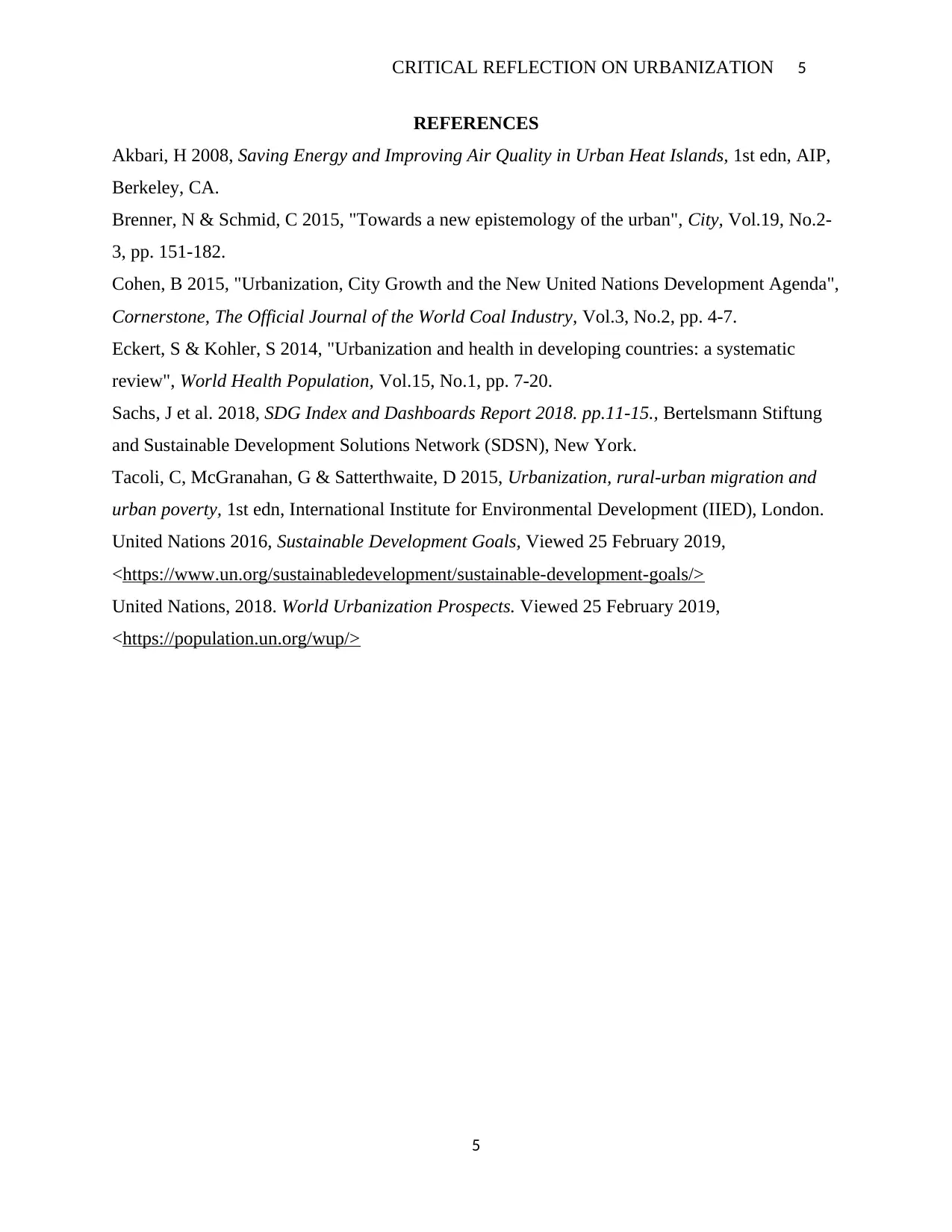
CRITICAL REFLECTION ON URBANIZATION 5
REFERENCES
Akbari, H 2008, Saving Energy and Improving Air Quality in Urban Heat Islands, 1st edn, AIP,
Berkeley, CA.
Brenner, N & Schmid, C 2015, "Towards a new epistemology of the urban", City, Vol.19, No.2-
3, pp. 151-182.
Cohen, B 2015, "Urbanization, City Growth and the New United Nations Development Agenda",
Cornerstone, The Official Journal of the World Coal Industry, Vol.3, No.2, pp. 4-7.
Eckert, S & Kohler, S 2014, "Urbanization and health in developing countries: a systematic
review", World Health Population, Vol.15, No.1, pp. 7-20.
Sachs, J et al. 2018, SDG Index and Dashboards Report 2018. pp.11-15., Bertelsmann Stiftung
and Sustainable Development Solutions Network (SDSN), New York.
Tacoli, C, McGranahan, G & Satterthwaite, D 2015, Urbanization, rural-urban migration and
urban poverty, 1st edn, International Institute for Environmental Development (IIED), London.
United Nations 2016, Sustainable Development Goals, Viewed 25 February 2019,
<https://www.un.org/sustainabledevelopment/sustainable-development-goals/>
United Nations, 2018. World Urbanization Prospects. Viewed 25 February 2019,
<https://population.un.org/wup/>
5
REFERENCES
Akbari, H 2008, Saving Energy and Improving Air Quality in Urban Heat Islands, 1st edn, AIP,
Berkeley, CA.
Brenner, N & Schmid, C 2015, "Towards a new epistemology of the urban", City, Vol.19, No.2-
3, pp. 151-182.
Cohen, B 2015, "Urbanization, City Growth and the New United Nations Development Agenda",
Cornerstone, The Official Journal of the World Coal Industry, Vol.3, No.2, pp. 4-7.
Eckert, S & Kohler, S 2014, "Urbanization and health in developing countries: a systematic
review", World Health Population, Vol.15, No.1, pp. 7-20.
Sachs, J et al. 2018, SDG Index and Dashboards Report 2018. pp.11-15., Bertelsmann Stiftung
and Sustainable Development Solutions Network (SDSN), New York.
Tacoli, C, McGranahan, G & Satterthwaite, D 2015, Urbanization, rural-urban migration and
urban poverty, 1st edn, International Institute for Environmental Development (IIED), London.
United Nations 2016, Sustainable Development Goals, Viewed 25 February 2019,
<https://www.un.org/sustainabledevelopment/sustainable-development-goals/>
United Nations, 2018. World Urbanization Prospects. Viewed 25 February 2019,
<https://population.un.org/wup/>
5
1 out of 5
Related Documents
Your All-in-One AI-Powered Toolkit for Academic Success.
+13062052269
info@desklib.com
Available 24*7 on WhatsApp / Email
![[object Object]](/_next/static/media/star-bottom.7253800d.svg)
Unlock your academic potential
Copyright © 2020–2025 A2Z Services. All Rights Reserved. Developed and managed by ZUCOL.





